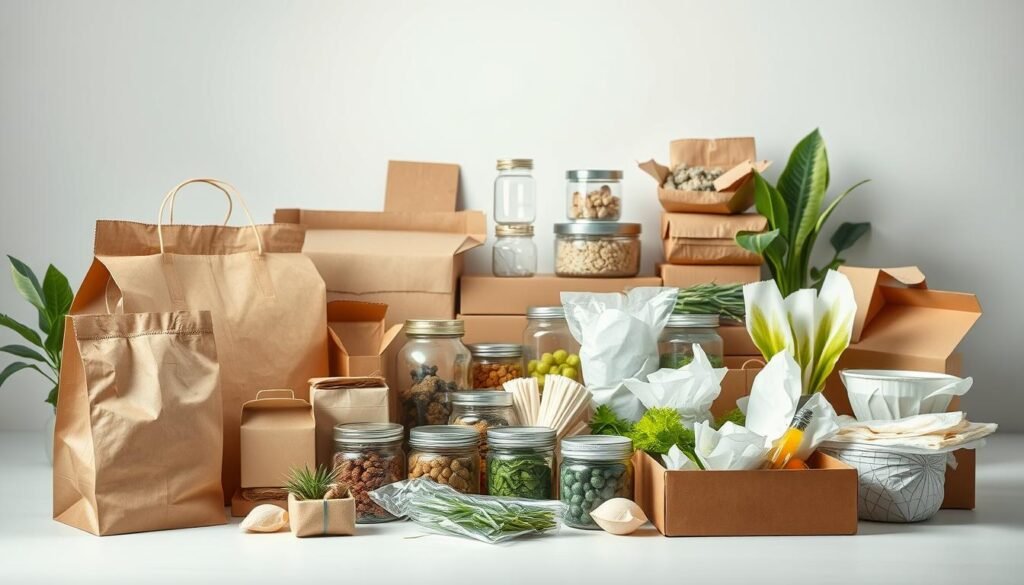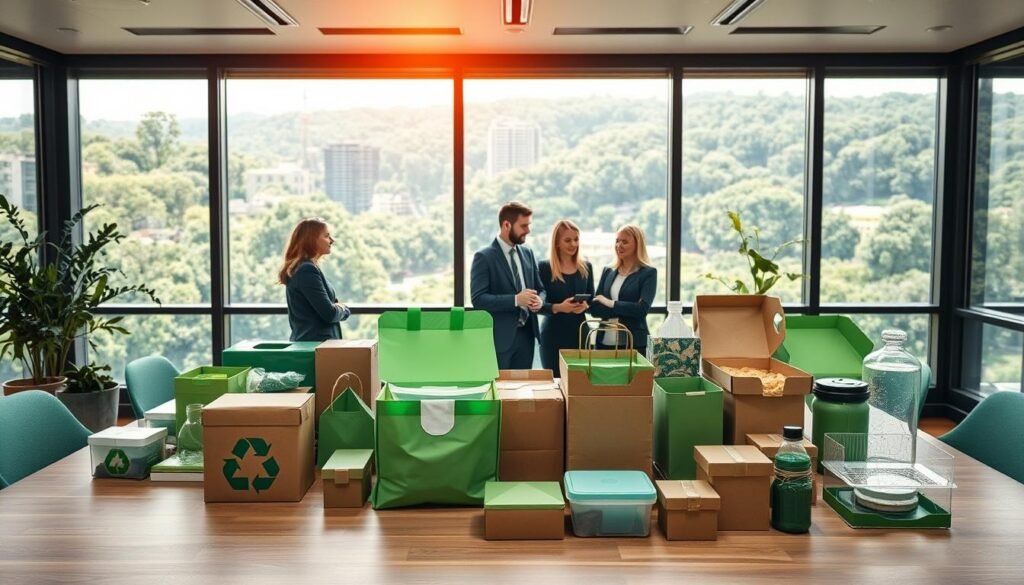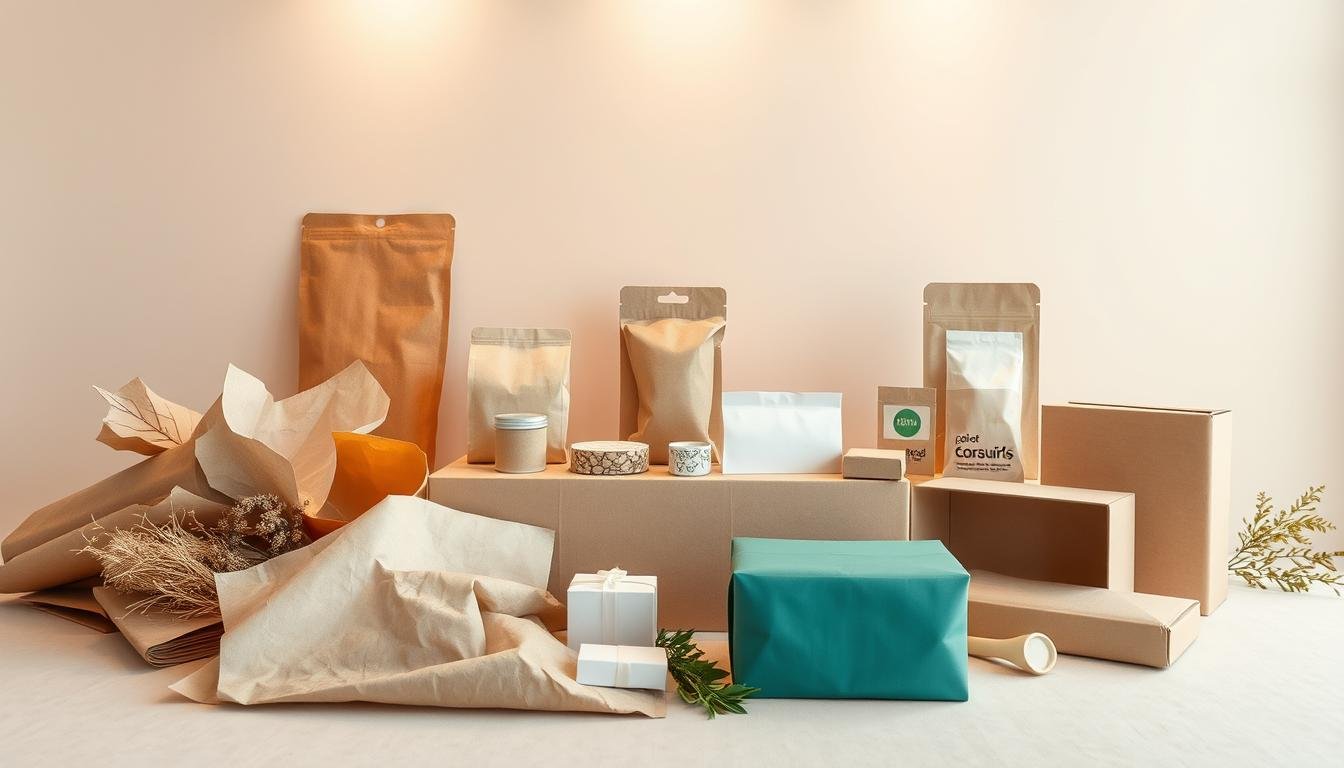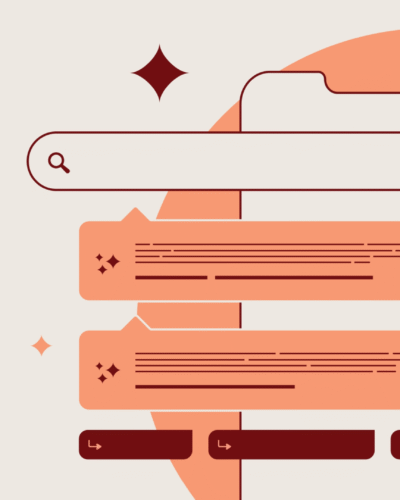“The future will either be green or not at all.” – Jonathon Porritt’s words highlight the need for eco-friendly packaging in our future. As we become more aware of our environmental impact, people want companies to offer quality products in environmentally friendly packaging. Companies are now turning to green packaging to meet these demands and help our planet.
Our growing awareness of the environment means we must adopt sustainable practices. This is not just a moral choice but a necessity for businesses to thrive and keep customers happy. Wholesale companies are leading the way by providing durable, eco-friendly options for shipping. These choices show their commitment to the environment.
Key Takeaways
- Understanding the importance of sustainable solutions in today’s market.
- Recognizing the environmental impact and consumer demand for green packaging.
- Exploring the various types of environmentally friendly packaging available.
- Identifying the role of sustainable practices in aligning with consumer preferences.
- Considering the benefits for businesses that implement eco-friendly packaging strategies.
Eco-friendly Packaging: A Path Towards Sustainability
Choosing sustainable packaging practices is more than just caring for the environment. It’s a key part of a brand’s strategy for any eco-conscious business. By picking green packaging alternatives, companies show they care about the planet. This message connects with today’s consumers and supports global goals for sustainability.
Using biodegradable materials is a big step towards sustainable packaging. These include plant-based plastics and organic fabrics that break down naturally. This reduces waste and pollution. Also, using recyclable materials like cardboard and some plastics helps. These can be turned into new products, saving raw materials.
The best choice for sustainable packaging practices is reusable materials. Items like glass or metal last longer. They also cut down on the need for single-use packaging. This helps move towards a circular economy where products last longer and waste is less.
When choosing green packaging alternatives, businesses must think about where the materials come from and how they’re made. Using 100% recycled content and ensuring fair labor practices boosts both the environment and company ethics. Here’s a table showing some sustainable materials, their sources, and benefits:
| Material | Source | Environmental Benefit |
|---|---|---|
| Biodegradable Plastic | Plant-based Polymers | Decomposes naturally, no toxic residues |
| Recycled Cardboard | Post-consumer Waste | Reduces landfill waste, conserves natural resources |
| Reusable Glass | Sand | Long lifespan, endlessly recyclable without quality loss |
Working on these efforts makes a brand look responsible and forward-thinking. It also attracts customers who want to support companies that care about the planet. This journey towards environmental stewardship through eco-conscious business decisions shows a brand’s dedication to sustainability.
The Rising Demand for Sustainable Solutions in Packaging
In today’s market, the move towards sustainable packaging is more than a trend. It’s a key economic need driven by growing consumer expectations and eco-aware consumers. The sustainable packaging market is shaped by green buying trends, mainly from the younger generations.
Consumer Expectations and Market Growth
More people want eco-friendly packaging from brands. This is shown by 82% of shoppers willing to pay extra for it. The sustainable packaging market is becoming a key part of brand strategy, matching eco-conscious values. The growth is fueled by better and more accessible sustainable materials and tech, improving efficiency and product quality.
Learn more about these changes in an insightful article on embracing sustainability in packaging.
The Role of Gen Z and Millennials in Eco-conscious Buying
Gen Z and Millennials are leading the way in green buying trends. About 90% of Gen Z shoppers are ready to spend more for eco-friendly packaging. Their influence pushes companies to rethink their packaging strategies, ensuring they meet current demands and build long-term loyalty.
| Demographic | Willingness to Pay More | Influence on Market Trends |
|---|---|---|
| Overall Consumers | 82% | High |
| Gen Z | 90% | Very High |
| Millennials | 85% | Very High |
Types of Sustainable Packaging Materials
The move towards eco-friendly packaging is more than a trend; it’s a must. We’re looking at biodegradable packaging, recyclable materials, and reusable packaging. These are key parts of circular economy solutions.

Biodegradable and Compostable Alternatives
There’s been big progress in biodegradable packaging. Materials like paper pulp and cornstarch-based plastics are leading the way. They break down easily, leaving little harm on the environment.
Compostable packages, like PLA plastics, also decompose into safe organic matter. This helps soil health.
Recyclable Materials: Beyond Plastics
Recyclable materials are now more than just plastics. We’re seeing cardboard, paperboard, and metals like aluminum being used. These are turned into new products efficiently.
This reduces waste and uses less energy than making raw materials.
Reusables: A Circular Economy Approach
Reusable packaging like glass jars and fabric totes show the circular economy in action. They encourage us to reuse, cutting down single-use waste. This promotes a greener way of living.
| Material Type | Environmental Benefit | Typical Usage |
|---|---|---|
| Biodegradable Plastics | Breaks down naturally | Single-use items, e.g., straws |
| Cardboard | Widely recyclable | Shipping boxes |
| Glass | 100% reusable | Beverage containers |
Innovations in Eco-friendly Packaging Solutions
The world of packaging is changing fast, thanks to innovative packaging solutions. New materials like seaweed packaging and algae ink are leading the way. They show great promise for a greener future.
Seaweed Packaging and Algae Ink
Seaweed packaging is a new, eco-friendly option. It breaks down easily and helps marine life. Algae ink is another green choice, made from algae instead of chemicals.
Both are big steps towards less pollution and saving natural resources.
For more on eco-friendly materials, check out this blog about earth-friendly packaging.
Advancements in Bioplastics Technology
New bioplastics made from corn and potato starch are exciting. They’re not only biodegradable but also cut down on carbon emissions. This makes them a promising alternative to regular plastics.
Here’s a look at how bioplastics compare to traditional plastics:
| Material Type | Production CO2 Emissions | Biodegradability | Usability in Packaging |
|---|---|---|---|
| Traditional Plastics | High | No | Widespread |
| Bioplastics (corn-based) | Low | Yes | Growing |
| Bioplastics (potato-based) | Moderate | Yes | Emerging |
Bioplastics are a greener choice, helping reduce waste and save resources. They meet the growing demand for sustainable packaging. As we move towards being more eco-friendly, these new packaging technologies are key.
Challenges Facing the Adoption of Sustainable Packaging
The move to sustainable packaging offers big environmental wins. Yet, it’s not without sustainable packaging challenges. Companies face financial, operational, and market hurdles. Knowing these eco-friendly adoption barriers is key for businesses aiming to make this change.
One big green packaging transition difficulty is the high cost of new materials. Biodegradable or compostable options are pricier than usual ones. Also, redesigning packaging to be eco-friendly without losing quality or customer satisfaction is tough.
- Cost: Switching to green packaging means using new, pricier materials and tech.
- Supply Chain Modifications: Changing supply chains for sustainable packaging is hard work.
- Regulatory Compliance: Dealing with many rules can be overwhelming and needs experts.
- Consumer Behavior: Getting people to try new packaging is hard, even in markets that like change.
Despite these hurdles, the benefits of eco-friendly packaging are clear. It can boost brand loyalty, help the environment, and meet future rules. Companies should be smart and patient, using new ideas and tech to beat these barriers.
Talking openly about these sustainable packaging challenges and green packaging transition difficulties helps. It lets businesses find ways to smoothly move towards being more eco-friendly. This way, they can protect the environment and stay profitable.
Case Studies: Success Stories in Sustainable Packaging
Looking into sustainable packaging case studies shows us how green brand leaders are changing the game. They’re not just switching to new materials. They’re also changing how we see brands and making a big difference for the planet.
Brands Leading the Way with Eco-friendly Packaging Choices
EcoEnclose is a top name in sustainable business. They use seaweed film and algae ink, showing they’re all about new ideas and caring for the earth. This helps win over customers who care about the planet.
Impact on Consumer Loyalty and Brand Perception
Switching to green packaging does more than help the environment. It also makes customers more loyal and boosts a brand’s image. When people see a brand going green, they feel it’s trustworthy and shares their values.
| Brand | Type of Packaging | Impact on Brand Perception |
|---|---|---|
| EcoEnclose | Seaweed Film | Highly Positive |
| Another Leader | Recycled Cardboard | Very Positive |
These sustainable packaging case studies show it’s possible to go green and win over customers. Moving towards eco-friendly practices is key for brands wanting to connect with today’s eco-aware shoppers.
The Economic Benefits of Eco-friendly Packaging
The world is moving towards sustainable practices, and eco-friendly packaging is key. It helps brands grow and saves money. It also makes operations more efficient. This change opens up new market chances for businesses.
Cost Savings and Operational Efficiency
- Using sustainable materials can cut down on costs.
- Streamlined packaging designs make supply chains more efficient.
- Companies avoid future fines by following environmental rules.
Companies that reduce waste and use eco-friendly materials save money. They also help the planet.
Market Opportunities for Eco-conscious Brands
- Green brands win customer loyalty and a better image.
- They reach out to customers who want eco-friendly products.
- They stand out in markets where being green matters.
There’s a big chance for brands that focus on the environment. This is because people want green products and laws are getting stricter.
Regulatory Landscape Influencing Sustainable Packaging
The world is moving towards sustainable packaging fast. This change is driven by stricter rules and a focus on the environment. Companies must quickly adjust to these new rules to keep up.
Rules on sustainable packaging are getting stronger. This means businesses need to follow eco-friendly practices to stay competitive.
Global Regulations and Compliance Requirements
Countries all over the world have set strict rules for packaging. This ensures companies use sustainable methods to meet global environmental standards. For example, the EU’s Directive on Packaging and Packaging Waste requires companies to use recycled materials more.
U.S. Specific Sustainability Legislation and Initiatives
In the U.S., laws on sustainability are changing fast. They show a strong commitment to protecting the environment and using sustainable packaging. Laws like the CLEAN Future Act and California’s AB 1200 aim to reduce harmful chemicals in packaging.
New York has banned Styrofoam, showing the impact of these laws. They push the industry to find greener solutions that meet tough standards.
How Businesses Can Transition to Eco-friendly Packaging
As industries worldwide aim for a greener future, they start with a detailed look at their current packaging. This involves understanding what they use now and planning for a more eco-friendly approach. It’s a big step towards a sustainable future.
Assessing Your Current Packaging Footprint
The first step is to check how your packaging affects the environment. By looking at what you use now, you can find ways to make it better. This helps in making your packaging more eco-friendly.

Strategies for Implementing Sustainable Packaging Solutions
Next, explore new materials and tech that are good for the planet. It’s important to keep your products safe and appealing to customers. A smart plan is key to making this change work for both your business and the environment.
| Strategy | Description | Benefits |
|---|---|---|
| Material substitution | Replacing traditional materials with more sustainable ones like bioplastics or recycled content. | Reduces environmental impact and often lowers material costs. |
| Design optimization | Redesigning packaging to use less material and improve logistics efficiency. | Decreases waste and transportation costs. |
| Collaborative partnerships | Working with supply chain partners who prioritize sustainability. | Enhances supply chain transparency and accelerates adoption of green practices. |
By focusing on these strategies, companies can become leaders in environmental care. They can grow their business and keep customers happy at the same time.
Conclusion
Sustainable packaging is now key for businesses, not just a nice thing to have. Companies worldwide see the value in green packaging. It boosts their image with customers and in their field.
The move to green packaging is smart and competitive. It meets the growing need for companies to care for the environment. This choice helps businesses stand out and grow.
New materials and innovations have changed packaging. They show that caring for the planet doesn’t mean sacrificing quality. Using biodegradable and recyclable materials helps brands build loyalty and grow.
Companies are now focusing on sustainability. This shift is driven by what customers want, new technology, and laws. Sustainable practices are key for businesses today.
As we move forward, caring for the environment is crucial for brands. Eco-friendly packaging is not just a choice but a must for those who want to make a difference.
FAQ
Why is eco-friendly packaging important for businesses today?
Eco-friendly packaging is key because customers want sustainable choices. It helps companies reduce their environmental impact. It also shows they care about values and meet rules, building trust and saving money.
What are some types of sustainable packaging materials?
There are many green packaging options. You can use biodegradable stuff like paper pulp and PLA. There are also recyclable materials like cardboard and some plastics. Plus, reusable items like glass containers and fabric totes help the planet.
How is the rise in consumer demand for sustainable packaging impacting the market?
More people are willing to pay extra for eco-friendly packaging. This is true for younger generations like Gen Z and Millennials. It’s making the market for green products grow, giving eco-friendly brands an edge.
What innovative eco-friendly packaging solutions are emerging in the industry?
New ideas are popping up. For example, seaweed film and algae ink are being used. Also, bioplastics made from corn and potato starch are becoming more common, offering green packaging choices.
What challenges might businesses face when transitioning to sustainable packaging?
Switching to green packaging can be tough. It might cost more at first and require changes in the supply chain. But, with careful planning and the right partners, these challenges can be overcome.
How does eco-friendly packaging benefit a brand’s reputation and consumer perception?
Green packaging boosts a brand’s image. People want to support companies that care about the planet. This shows loyalty and makes the brand stand out.
Can eco-friendly packaging lead to cost savings for companies?
Yes, it can. Using less material and designing packaging wisely can cut costs. It also helps the environment. Plus, as the demand for green products grows, businesses can become more efficient.
What does the regulatory landscape look like for sustainable packaging?
Laws are getting friendlier to green packaging. The CLEAN Future Act and state laws like New York’s Styrofoam ban encourage sustainable choices. Following these rules is key for businesses.
What steps should businesses take to transition to eco-friendly packaging?
First, check your current packaging and supply chain. Look into sustainable materials that fit your goals. Then, redesign your packaging to be more efficient. Share your commitment to green practices and work with experts to make the switch.
Are there any success stories of brands effectively using sustainable packaging?
Yes! Companies like EcoEnclose are leading the way. They use cool materials like seaweed film and algae ink. Their green efforts have earned them lots of support from customers.




